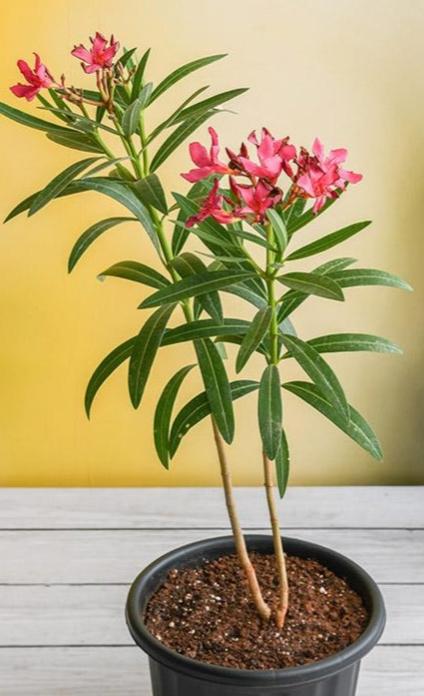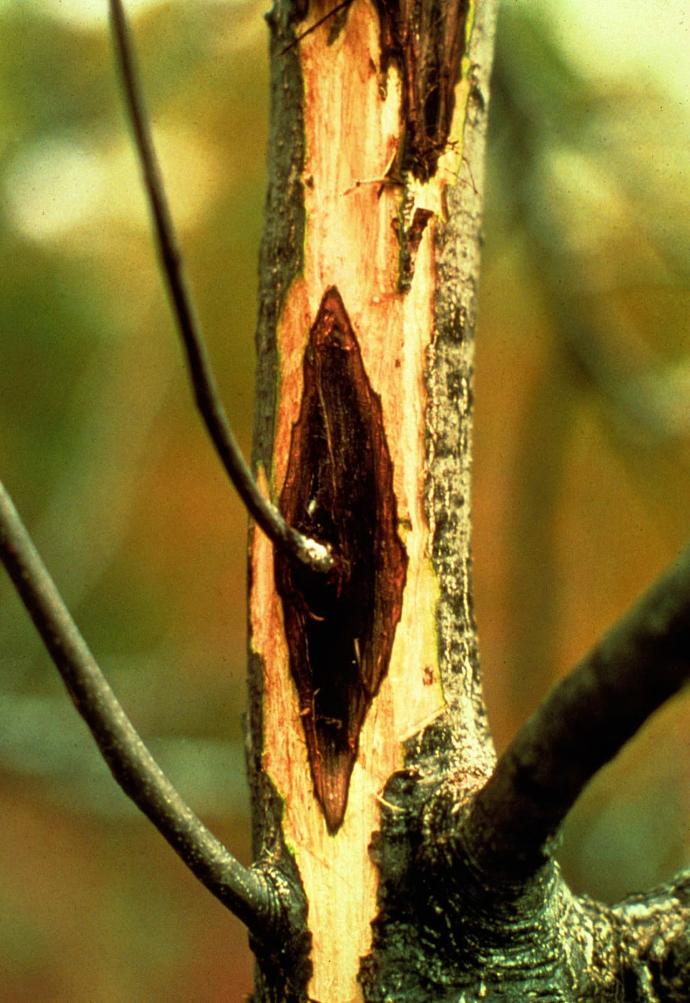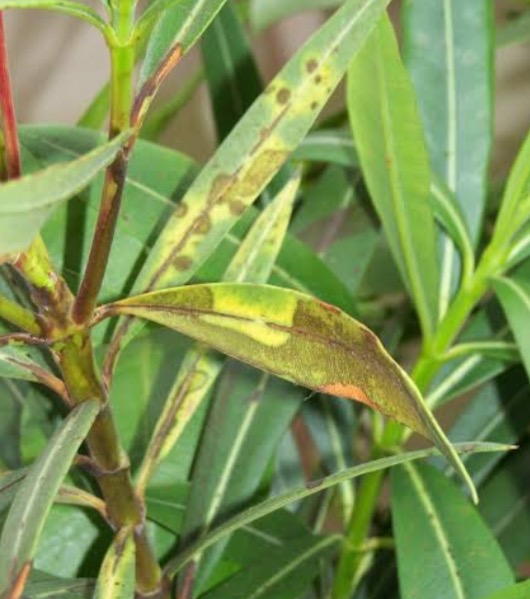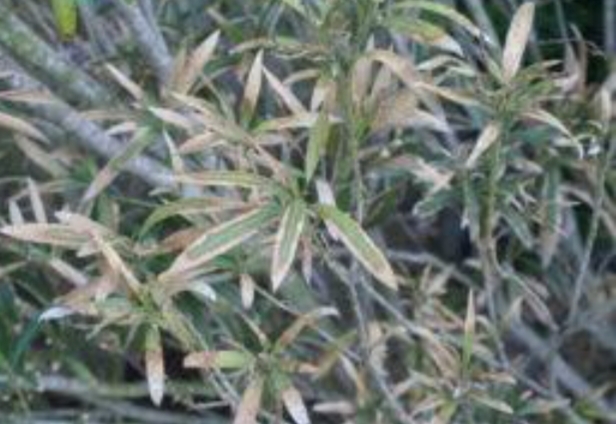Dwarf Nerium Plant
Dwarf Nerium, or Oleander, is an outdoor flowering shrub. Plant in well-draining soil with full sun exposure. Water consistently, and prune to shape the shrub. Fertilize during the growing season for optimal flower production. Note: Oleander is toxic; handle with care.

Habit
Shrub
Height
0.5-1.0 m
Growth
Fast
Soil
Well Drained, Loamy
Shade
Full Sun
Moisture
Moist
Edible
No
Medicinal
No
Origin
Mediterranean
Climatic Condition
Subtropical to Tropical
Temperature (°)
18-30°C
Humidity (%)
60-70%
Potting media
Peat-based mix
Fertilizers
Balanced fertilizer
Watering
Regular watering; allow topsoil to dry between waterings
Plant Weight
0.3-1 kg
Flowering Time
Spring to Summer
Soil Ph level
6.0 - 7.5
Water Ph level
6.0 - 7.0
Soil EC
0.3 - 0.5
Yield Per Plant
Ornamental use
NPK ratio
10:10:10
life Span
Perennial
Health Benefits
Used for ornamental purposes; toxic if ingested
Suggested Grow Media or Potting Mix ?
50% loamy soil, 30% compost, 20% sand
Suggested Fertigation/Fertilizers
Fertilize every 4 weeks with a balanced fertilizer.
Common Diseases and Remedies
Blight, canker, Anthracnose, Root rot
Brown spots and yellow spots appear on the leaf. Water soaked lesions are formed.
Avoid over watering and remove the effected part of the plant.
What Is A Dwarf Nerium Tree?
A dwarf nerium plant is a compact variety of the Nerium oleander, a shrub known for its attractive flowers and evergreen foliage. These dwarf varieties typically reach smaller heights compared to their standard counterparts, making them suitable for smaller gardens or container planting. Despite their smaller size, they still produce vibrant blooms in various colors, including pink, white, and red, adding beauty to outdoor spaces while requiring minimal maintenance.

What are the different types of dwarf nerium plant?
There are several different types of dwarf nerium plants, each with its own unique characteristics and features. Some popular varieties include:
1. Dwarf Red:
This variety produces vibrant red flowers and has a compact growth habit, making it suitable for small spaces or container planting.
2. Dwarf Pink:
Known for its soft pink blooms, this variety adds a delicate touch to gardens or landscapes while maintaining a smaller size.
3. Dwarf White:
With its crisp white flowers, this variety offers a classic and elegant look, perfect for brightening up any outdoor space.
4. Dwarf Variegated:
This type features variegated foliage with creamy white or yellow margins, adding visual interest even when not in bloom.
5. Dwarf Double Flowered:
These varieties produce double blooms, creating a fuller and more abundant display of flowers compared to single-flowered varieties.

How to care for dwarf nerium plant?
1. Location:
Dwarf nerium plants thrive in locations with plenty of sunlight, ideally receiving at least 6 hours of direct sunlight each day. Choose a spot in your garden or landscape that provides full sun exposure, such as a south-facing area. Ensure the location has well-draining soil to prevent waterlogging, as nerium plants prefer slightly dry conditions. Additionally, consider the plant's mature size and leave enough space for it to grow without overcrowding other plants
2.Sunshine:
Dwarf nerium plants require abundant sunshine to thrive. Aim for a location that receives full sun, meaning at least 6 hours of direct sunlight per day. Inadequate sunlight can result in reduced flowering and overall poor growth. Placing them in a sunny spot ensures they receive the energy needed for photosynthesis, which promotes lush foliage and vibrant blooms. So, ample sunshine is crucial for the health and vigor of dwarf nerium plants.
3.Soil:
For dwarf nerium plants, it's essential to use well-draining soil. A mixture of potting soil and perlite or sand works well. This combination ensures adequate drainage, preventing waterlogging, which can lead to root rot. Additionally, incorporating organic matter into the soil helps provide essential nutrients for the plant's growth. Overall, a well-draining soil mixture with good aeration is crucial for the health and vitality of dwarf nerium plants, promoting strong root development and lush foliage.
4.Hydration:
Hydration for dwarf nerium plants should strike a balance between keeping the soil evenly moist and avoiding overwatering. Water deeply but infrequently, allowing the top inch or two of soil to dry out between waterings. This encourages healthy root development while preventing waterlogged conditions that can lead to root rot. During hot or dry periods, increase watering frequency, but always check the soil moisture before watering to avoid excess moisture buildup. Proper hydration ensures that dwarf nerium plants remain healthy and vibrant, promoting lush foliage and abundant flowering.

5.Nourishment:
For nourishing dwarf nerium plants, use a balanced, slow-release fertilizer formulated for flowering shrubs. Apply the fertilizer in the spring according to the instructions on the package. This provides essential nutrients such as nitrogen, phosphorus, and potassium, promoting healthy growth, lush foliage, and vibrant blooms.
6.Issues:
Dwarf nerium plants can face several issues, including: Common pests such as aphids, scale insects, and caterpillars can infest dwarf nerium plants, causing damage to foliage and flowers. Regular inspection and appropriate pest management measures, such as insecticidal soap or neem oil applications, can help control infestations. Fungal diseases like powdery mildew and leaf spot can affect dwarf nerium plants, especially in humid conditions. Providing good air circulation, avoiding overhead watering, and applying fungicidal treatments as needed can help prevent and manage fungal infections. Insufficient nutrients in the soil can lead to nutrient deficiencies in dwarf nerium plants, resulting in yellowing leaves, stunted growth, and poor flowering. Regular fertilization with a balanced fertilizer can help prevent nutrient deficiencies and promote healthy growth.
What are the benefits of the dwarf nerium plant?
The benefits of dwarf nerium plants include: Attractive Flowers, Compact Size, Evergreen Foliage, Low Maintenance, Drought Tolerance.

FAQS about growing Dwarf Nerium Plant
1.What are the ideal growing conditions for the dwarf nerium plant?
The ideal growing conditions for dwarf nerium plants include:
They thrive in full sunlight, receiving at least 6 hours of direct sunlight per day. Placing them in a sunny spot ensures vigorous growth and abundant flowering. Use well-draining soil rich in organic matter. A mix of potting soil and perlite or sand works well, ensuring adequate drainage to prevent waterlogging. Water deeply but infrequently, allowing the top inch or two of soil to dry out between waterings. Avoid overwatering, as it can lead to root rot. Dwarf nerium plants prefer warm temperatures and are sensitive to frost. Plant them in locations with mild winters or consider protecting them during cold spells.
2.Are there any specific pruning requirements for dwarf nerium plants?
Pruning is best done in late winter or early spring before new growth begins. This allows the plant to recover and produce new growth and flowers during the growing season. Start by removing any dead, damaged, or diseased branches. Cut them back to healthy tissue using sharp, clean pruning shears. This helps improve the overall appearance and health of the plant. Prune to shape the plant as desired, maintaining a balanced and attractive form. You can trim back any overly long or unruly branches to encourage a more compact growth habit. To promote flowering, selectively prune branches to open up the canopy and allow sunlight to reach the interior of the plant. This can stimulate flower bud formation and increase flower production.Wear gloves when pruning dwarf nerium plants, as the sap can be irritating to the skin. Additionally, ensure that your pruning tools are sharp and clean to make precise cuts and prevent the spread of diseases.
3.Can dwarf nerium plants tolerate frost or cold temperatures?
Dwarf nerium plants are not particularly frost-tolerant and can be damaged or killed by freezing temperatures. While they can withstand brief periods of cold weather, prolonged exposure to frost or freezing temperatures can harm the plant, causing foliage to wilt, turn brown, or drop off. In regions with mild winters, dwarf nerium plants may survive outdoors with some protection during occasional cold snaps.
4.How do I propagate dwarf nerium plant?
Softwood Cuttings , Hardwood Cuttings
5.Are there any special considerations for overwintering dwarf nerium plants in colder climates?
Protection from Frost, Reduce Watering, Prune Sparingly, Monitor for Pests and Diseases.



